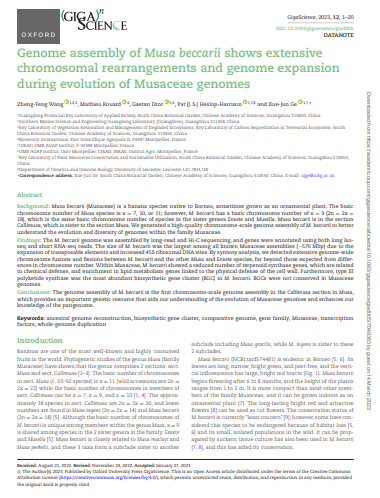Background
Musa beccarii (Musaceae) is a banana species native to Borneo, sometimes grown as an ornamental plant. The basic chromosome number of Musa species is x = 7, 10, or 11; however, M. beccarii has a basic chromosome number of x = 9 (2n = 2x = 18), which is the same basic chromosome number of species in the sister genera Ensete and Musella. Musa beccarii is in the section Callimusa, which is sister to the section Musa. We generated a high-quality chromosome-scale genome assembly of M. beccarii to better understand the evolution and diversity of genomes within the family Musaceae.
Findings
The M. beccarii genome was assembled by long-read and Hi-C sequencing, and genes were annotated using both long Iso-seq and short RNA-seq reads. The size of M. beccarii was the largest among all known Musaceae assemblies (∼570 Mbp) due to the expansion of transposable elements and increased 45S ribosomal DNA sites. By synteny analysis, we detected extensive genome-wide chromosome fusions and fissions between M. beccarii and the other Musa and Ensete species, far beyond those expected from differences in chromosome number. Within Musaceae, M. beccarii showed a reduced number of terpenoid synthase genes, which are related to chemical defense, and enrichment in lipid metabolism genes linked to the physical defense of the cell wall. Furthermore, type III polyketide synthase was the most abundant biosynthetic gene cluster (BGC) in M. beccarii. BGCs were not conserved in Musaceae genomes.
Conclusions
The genome assembly of M. beccarii is the first chromosome-scale genome assembly in the Callimusa section in Musa, which provides an important genetic resource that aids our understanding of the evolution of Musaceae genomes and enhances our knowledge of the pangenome.
Wang, Z-F.; Rouard, M.; Droc, G.; Heslop-Harrison, P. Ge, X-J

